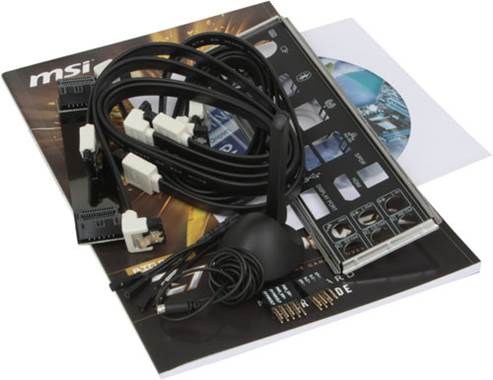This mainboard shows off many
upsides. Some are similar to other typical Micro-Star mainboards, some are
exclusive. However, they are quite hard to work with and require your good
patience.
Micro-Star mainboard from the Big Bang
series have the same characteristic: the name. The products, completely
different from other series, are designed to meet different processors and
platforms and to have various functions, bearing no difference to the brand’s
main product. They can boast about recognizably distinctive features such as the
compatibility with graphic cards from different companies or a lot of PCI
Express ports, but when MSI Z77 POWER entered this series, it may seem strange
at first. Seemingly a common mainboard couldn’t stand out of other models. It
was also produced by using hi-quality “Military Class III” component whose warranty
and stability are recognized the certificate accompanied, like for other usual
mainboards. It’s distinctive that this mainboard passed an additional test after
coming through all quality controls. This is not a normal test but an intense 24-hour
test of an overclocked in the famous Prime95 utility, which creates heavy
complex loads. This stressful test not only aims at operation but also confirms
the mainboard’s overclocking potential and allows marking it as “OC
Certificated”.

“OC
Certificated”
I must say that the OC certification
procedure is solely the distinctive feature to recognize MSI Z77 MPOWER, yet
not the only feature. In our review, we tend to reveal new characteristics and
functions that we have never seen in any Micro-Star mainboards, new BIOS and
new threats. All of these as well as power consumption and much more will be
discussed in this article.
Packing and accessories
Like other Micro-Star from BB series, the
front of MSI Z77 MPOWER box is decorated with a big explosion.
The front can be flipped open, to reveal a
large picture and a list of crucial functions

The
front can be flipped open.
Continue to describing the back, where you
can find picture of the mainboard’s back control panel and its official
technical specs
Beside the mainboard packed in an
anti-static bag, you will find the following accessories:
·
Four ATA cables with metal connector locks, half
with L-shaped and another half with straight types
·
A flexible bridge for configuring 2-way NVidia
SLI graphics
·
A Wi-Fi antenna
·
I/O Shield for the back panel
·
“M-Connector” lock including modules supporting
easy connection to the front case’s buttons, indicators and sound
·
“V-Check Cable” adapter set for monitoring voltage
manually with a voltmeter
·
User manual
·
A booklet on proprietary software
·
Illustrated guide for overclocking
·
A booklet summarizing assembly instructions
·
Reliability certificate listing all component
testing methods
·
DVD with software and drivers

Accessories
Design and function
I must say that the picture of MSI Z77
doesn’t seem attractive: only the decorative stripes on the heat-sinks brighten
up the dark black and gray PCB. But, the board is very pleased when working:
you could tell it’s a hi-quality product well made from the start, although I
have to say that the color-coding of the memory DIMMs, graphics card ports and
SATA connectors can make its exterior a bit funnier and make the assembly
process a little easier.
One of the typical features of Micro-Star mainboards
is using hi-quality “Military Class III” components, which sturdiness and
stability are guaranteed by the accompanying certificate. The heating
components of the digital processor voltage regulator circuitry are topped with
two sophisticatedly shaped heat-sinks. A thick 8 mm (instead of 6mm like from
other manufacturers) heat-pipe connects these heat-sinks to the center, which
doesn’t cover any special components but simply provides additional
heat-dissipating surface and shows off the device hi-end rank. All heat-sinks
including the fourth one on the chipset are tightly attached with screws.

The
mainboard
The mainboard can get one discrete graphics
accelerator to work at full speed of PCI Express 3.0/2.0 x16, or two to work at
x8 speed. If you are using an Ivy Bridge processor, you will have a third slot
at disposal, but the slot operating speeds will switch to x8/x4/x4, according
to function of the Intel Z77 Express chipset used in this board. You can set up
ATI CrossFire or NVidia SLI graphics configurations inside. In addition, there
are 4 PCI Express 2.0 x1 slots for extended cards. The chipset also supplies
the board with two SATA 6Gbps ports and four SATA 3Gbps ports. There’s no
additional onboard SATA controller.
The back panel of the mainboard provides
the following ports and connectors:
·
PS/2 connector for keyboard or mouse
·
Two USB 2.0 connectors, six USB ports are
available as three onboard pin-connectors
·
Clear CMOS button
·
Two USB 3.0 connectors (blue connectors) operated
via Intel Z77 Express chipset, other four ports are operated through Renesas
µPD720201 controller, plus there is also an onboard pin-connector for two more
USB 3.0 contacts
·
Bluetooth 3.0+HS and Wi-Fi IEEE 802.11 b/g/n
wireless module
·
A local network port (network adapter is built
on Gigabit Realtek RTL8111E controller)
·
Outputs for HDMI and DisplayPort Video
·
Optical S/PDIF plus six analogue-audio jacks
provided by the eight-channel Realtek ALC898 codec

Connectors
There, I need you to pay attention to some
points. First, this is for our first-time experience of a Micro-Star mainboard
integrated with wireless technologies. There were other mainboards, but we
didn’t have any chance to test them, except for some very old MSI mainboards
that came with a separate Bluetooth module. Second, the USB 3.0 ports in the
chipset are accompanied by a Renesas controller. Only the earliest mainboards
with USB 3.0 support were equipped with Renesas (NEC) controllers, but lately they
have been almost replaced with controllers from other manufacturers. So, why
are these chips still used in MSI mainboards? Because Renesas µPD720201 is a
new four-port controller, which belongs to the third generation of USB 3.0
controllers from Renesas. These new chipsets are more compact, more energy-saving
and even faster than the predecessors. These were all undeniable advantages of
the back panel layout. The only disadvantage is the lack of the eSATA port.
The layout
I would like to show you several other
peculiarities of the mainboard. The graphic card slot has convenient and wide
latches. The CPU Phase LEDs indicate the number of running phases in the
processor voltage regulator circuitry, which automatically changes depending on
the operational load. In addition of Power On, Reset and Clear CMOS buttons,
there is also an OC Genie button, allowing for automatic overclocking the
system. Another useful feature is GO2BIOS button, which will enable you to
enter the BIOS upon the next boot-up without any of your effort. There is a
special switch allowing you to assign one of the two independent BIOS chips as
primary. The POST code indicator will help to identify start-up problems. You
can use V-Check Points and enclose V-Check Cables to measure all important
voltages manually. An additional six-pin connector that supplies power for
multi-card graphic configuration is a controversial advantage, because the
existing power supply connectors won’t be free and you have to use some kind of
adapter for that. There are five four-pin fan connectors. Four system fan
connectors allow for lowering the fan rotation speed even if you are using a
three-pin fan, but it won’t work with a CPU fan.